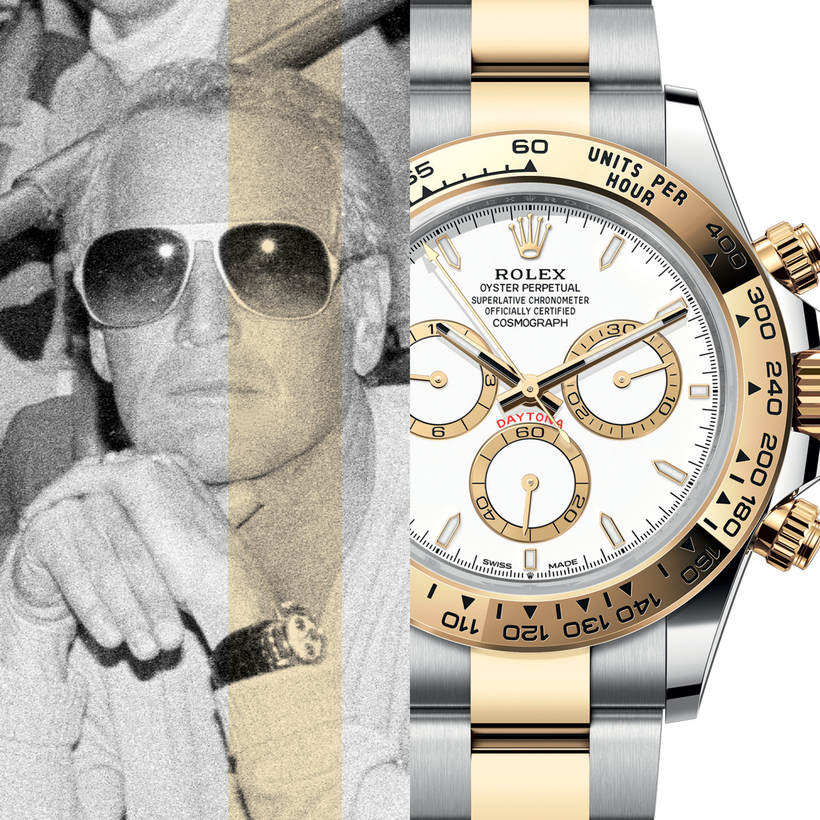One morning in 1908, “while riding on the upper deck of a horse-drawn omnibus along Cheapside in the City of London, a genie whispered ‘Rolex’ in my ear.” The ear into which that supernatural being whispered belonged to the 27-year-old Hans Wilsdorf, a German émigré with a business importing and distributing timepieces. On July 2 of that year he registered that strange five-letter word as a trademark in Switzerland.
The derivation and meaning of the word continue to be debated: some believe it to be acronymic and to come from “hoROLogical EXcellence,” or, even more prosaically, “ROLling EXport.” Lost in time, or buried deep in the archives of Rolex, the exact origins of the name are now irrelevant. Meaning was destined to come with time. That word, which, 115 years ago, was equally meaningless in all languages, is now known around the world, and Wilsdorf’s fanciful explanation brings a pleasing touch of magic realism to the otherwise pragmatic life of a young entrepreneur in Edwardian London.
This year, Rolex recalled that bus ride through bustling early-20th-century London when it named a new watch, simply, Perpetual 1908.
Rolex’s booth at this year’s Watches and Wonders Fair in Geneva was a horological horn of plenty, brimming with exciting new watches. Given that this is the 60th anniversary of the launch of the Rolex Daytona—notably worn by Paul Newman—it was easy to predict that Rolex was going to refresh that celebrated chronograph, and it duly did, but in such a way that you need to be a Rolex obsessive in order to identify.
Only when examined side by side with the old model do subtle changes in lugs, crown guards, and hour markers become apparent. Inside the case there is a new movement and, for the first time in a Rolex sports watch, you can see what it looks like, at least if you are fortunate enough to get your hands on the platinum version, which features a crystal caseback that permits the wearer to turn the watch over and inspect the movement.
But, mirabile dictu, the Daytona had a little of its limelight poached when it was upstaged by two other watches that you did not need to be a scholar of Rolex studies to identify as new.
First was the watch now known informally as the “Emoji Day-Date,” which marks an extraordinary departure. It turns Rolex’s signature calendrical watch—which shows the day in an arched window at 12 o’clock and the date under a magnifying bubble at 3 o’clock—into a motivational-inspirational tool with words including “gratitude” and “love” appearing in place of the day, and 31 rotating emojis (including a smiling pumpkin, a pink unicorn, and the Rolex crown) instead of the date.

And just to make sure that you noticed the difference, the watch featured a polychrome champlevé-enamel dial (a technique in which hollows etched into a metal surface are filled with enamel) depicting jigsaw-puzzle pieces in bright colors: turquoise, fuchsia, red, orange, green, and yellow—each, says the brand, “representing one of the key moments in life.” Which moments are not specified.
“A genie whispered ‘Rolex’ in my ear.”
The other was arguably even more radical: a titanium Yacht-Master 42. Light and resilient, titanium is not new to the watch industry, but it was only last year that the Deepsea Challenge, Rolex’s extreme-deep-dive watch, based on the model developed for the film director James Cameron on his 6.7 mile descent into the Mariana Trench in 2012, became the first Rolex with a case and bracelet made from titanium.
Now it introduces the material into the Yacht-Master range, an obvious candidate given Rolex’s involvement with SailGP, a sort of Formula 1 of sailing in which crews compete in specialized high-performance foiling catamarans that seem almost to fly above the waves. It is a sport in which lightness is everything.
Given all this excitement, and the tendency for collectors to focus on the brand’s “Professional” and sports watches, the slightly retro 1908 slipped by almost without notice, and yet it is one of the more significant launches of recent years for Rolex. Confirmation of its significance came at the Met Ball, in New York, where Rolex ambassador Roger Federer, standing out in a classic tuxedo against the cavalcade of outré costumes, was wearing it.

This, then, is Rolex’s idea of what a black-tie watch should be. Its plain dial with Arabic-numeral hour markers at 9, 12, and 3 o’clock, chemin de fer minute track, and a seconds dial at 6 is a model of restraint. A period feel is imparted by the hour hand, which features a circle before its tip, and the fine coin-edge-style fluting on the bezel, while the caseback is a nod to the Rolex Oyster Perpetuals of the early 1930s.
It replaces the Cellini line. During the 1960s, 1970s, and into the 1980s, this range, named after the famed Renaissance goldsmith, produced some of the funkiest timepieces ever issued by Rolex, and recent years have seen a re-discovery of the celebrated King Midas (favored by John Wayne and Elvis Presley) by a fashion-conscious crowd including the Weeknd.
I am a huge fan of the Midas and its derivatives, but more recent Cellinis have neither replicated the Midas’s glorious eccentricity of design nor been fully convincing as conservative dress watches, in part because they have used the robust, solid, larger movements of the Professional models, which have dictated thicker cases.
As Rolex C.E.O. Jean-Frédéric Dufour explained to me, using an automotive analogy: “We wanted to have a classic watch made with classic parts, because the former Cellinis were made a little bit like building a sports model in the car industry with S.U.V. parts. The caliber was too thick, so the watch was nice when you were looking at it from far away, but then when you start looking at the details you said, ‘Oh my God, this is very thick for a classic watch.’”

The 1908 is fitted with a brand-new caliber, the 7140, which is built to tolerances that required Rolex to set up what was in effect a factory within a factory to make it. The spec is certainly impressive, including not just the metaphorical bells and whistles but tocsins and klaxons too: an energy-efficient, magnetism-resistant “Chronergy” escapement, Rolex’s patented “Syloxi” hairspring, “Paraflex” shock absorbers, and a 66-hour power reserve. Like the prestigious platinum Daytona, the 1908 features a crystal caseback, a feature traditionally associated with fine watchmaking, showing the striped Rolex Côtes de Genève engraving.
But what really impresses is that they have worked hard to put all this in a compact package. The watch is 9.5-mm. high because the movement is only 4.05-mm. high. (By comparison, the “S.U.V.” movement used in the popular Submariner is 6.18-mm. high.)
The result is that apparent oxymoron: a Rolex for people who don’t usually wear a Rolex.
Nicholas Foulkes, the author of more than 20 books on the arts and history, is a London-based writer and editor


